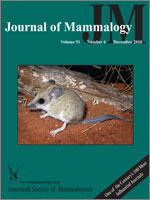Ontogenetic allometries of craniomandibular and dental features linked to digging were analyzed in 5 species of the South American subterranean rodent Ctenomys (tuco-tucos). With the exception of upper incisor procumbency, variables showed high correlation with overall skull size. In particular, craniomandibular variables related to the production of bite forces at the incisors showed near-geometric similarity during postnatal growth and interspecific changes in early developmental stages resulting in different starting forms (lateral transposition). Such an interspecific pattern of change is similar to one previously reported to occur among living and extinct ctenomyid genera. These results suggest more evolutionary flexibility for changes in early ontogenetic stages and allow rejection of the hypothesis that interspecific shape differences in the skull of Ctenomys would be associated with differences in size alone.
BioOne.org will be down briefly for maintenance on 14 May 2025 between 18:00-22:00 Pacific Time US. We apologize for any inconvenience.
How to translate text using browser tools
16 December 2010
Ontogenetic trajectories of key morphofunctional cranial traits in South American subterranean ctenomyid rodents
Diego H. Verzi,
Alicia Álvarez,
A. Itatí Olivares,
Cecilia C. Morgan,
Aldo I. Vassallo
ACCESS THE FULL ARTICLE

Journal of Mammalogy
Vol. 91 • No. 6
December 2010
Vol. 91 • No. 6
December 2010
craniomandibular traits
ctenomyid rodents
ontogenetic allometries
subterranean habits




